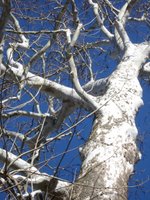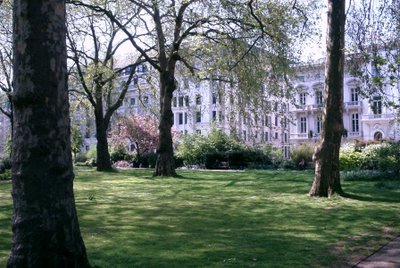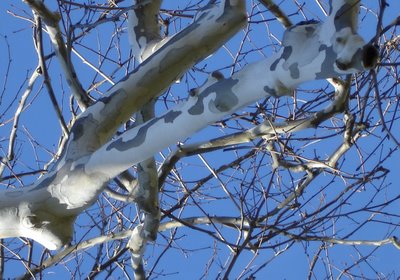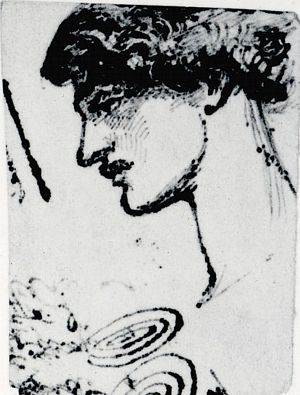Trees I have loved.
 But I was reminded this afternoon, as I shivered my way home from the bookstore, of a great mnemonic from my childhood. The sun was starting its slide into lowering gold, and so the sky in the east was a stunning blue, all the better to set off the enormous sycamore tree on a corner across the street from downtown Gambier. When they're not in leaf, sycamores are really able to show off the white brilliance of their upper branches, where their bark is either still forming or has already fallen off. Sycamores, see, have this funny bark that peels off in sheets on a more or less regular basis. And one way to interpret their appearance is to view them as being sick, though they're far from it; in fact, I've heard it argued that plane trees (of which the American sycamore is a variety) make the ideal urban tree because they're constantly shedding old bark, and because their leaves are large and glossy and thus easily washed by even a small amount of rain. But I suppose that when one is teaching elementary school children about trees, one does whatever one can to help them learn, and so, when I was little, I learned to remember "sycamore" because its name included "sick" and its skin seemed "sick" as well.
But I was reminded this afternoon, as I shivered my way home from the bookstore, of a great mnemonic from my childhood. The sun was starting its slide into lowering gold, and so the sky in the east was a stunning blue, all the better to set off the enormous sycamore tree on a corner across the street from downtown Gambier. When they're not in leaf, sycamores are really able to show off the white brilliance of their upper branches, where their bark is either still forming or has already fallen off. Sycamores, see, have this funny bark that peels off in sheets on a more or less regular basis. And one way to interpret their appearance is to view them as being sick, though they're far from it; in fact, I've heard it argued that plane trees (of which the American sycamore is a variety) make the ideal urban tree because they're constantly shedding old bark, and because their leaves are large and glossy and thus easily washed by even a small amount of rain. But I suppose that when one is teaching elementary school children about trees, one does whatever one can to help them learn, and so, when I was little, I learned to remember "sycamore" because its name included "sick" and its skin seemed "sick" as well. As I walked the half-mile home this afternoon, the Brooklyn Street sycamore branched its white fingers through my brain, trying to wrest some companion trees for itself. And sure enough, they started to appear, in all their exfoliating glory:
As I walked the half-mile home this afternoon, the Brooklyn Street sycamore branched its white fingers through my brain, trying to wrest some companion trees for itself. And sure enough, they started to appear, in all their exfoliating glory:My best, my first, sycamore trees grew along the side of the ditch at the bottom of my family's six acres in the first town we lived in in Indiana. My brother and I called this ditch the stream, because it rambled its own way along the east edge of our property, a good quarter-mile from the house, and thus felt as wild, as unpredictable and natural, as the Muscatatuck River, which flowed through the county and gave its name to our local state park and wildlife refuge. It had stony rapids, sandy shoals, pebbly shallows. It had minnows and, in the spring and summer, crayfish. It had narrows we could cross without getting wet, and it had wider passages where we needed to improvise bridges and steps. At one of these widenings, an enormous sycamore had put its roots down in the stream's sandy bank and grown to a prodigious height. Because there wasn't much bank on its side of the stream, I generally observed it from the other side, but occasionally the weather would change the stream's complexion just enough to allow me to get closer to the sycamore, even to balance on one of its roots, for a different (though not better) view of its variegated bark, patchworked of browns and drab greens and greys and bright whites. What I remember--and what I probably couldn't check, even if I were in southern Indiana right now, because as far as I know that tree is long gone, and the stream certainly is--is that the tree had somehow stretched its trunk, or perhaps the uppermost, hardest-barked part of its root system, along the bank, so that a substantial length of itself grew horizontal before making the turn skyward.
 When we were about to move to Indiana (not India, as I initially thought, when my mother first delivered the news to my six-year-old self), my parents bought me the green vinyl covered Audubon Society Field Guide to North American Birds (Eastern Region), for use in our new home. A couple years later, they supplemented it with the Field Guide to North American Trees (Eastern Region). (I thought I had gotten those books closer together, but the brown tree guide is copyrighted 1985, so my memory is proven wrong.) The tree guide got a lot less use than the bird guide, whose spine lost much of its white-printed title over the years. But both books have been close to hand for a couple of decades now. The tree guide tells me that in fact my memory is right on: the habitat of the "American sycamore," aka the "American Planetree," aka Platanus occidentalis, is "wet soils of stream banks, flood plains, and edges of lakes and swamps." It also characterizes this tree in a way I quite like: "Sycamore pioneers on exposed upland sites such as old fields and strip mines.... The present champion's trunk is about 11' (3.4 m) in diameter; an earlier giant's was nearly 15' (4.6 m).
When we were about to move to Indiana (not India, as I initially thought, when my mother first delivered the news to my six-year-old self), my parents bought me the green vinyl covered Audubon Society Field Guide to North American Birds (Eastern Region), for use in our new home. A couple years later, they supplemented it with the Field Guide to North American Trees (Eastern Region). (I thought I had gotten those books closer together, but the brown tree guide is copyrighted 1985, so my memory is proven wrong.) The tree guide got a lot less use than the bird guide, whose spine lost much of its white-printed title over the years. But both books have been close to hand for a couple of decades now. The tree guide tells me that in fact my memory is right on: the habitat of the "American sycamore," aka the "American Planetree," aka Platanus occidentalis, is "wet soils of stream banks, flood plains, and edges of lakes and swamps." It also characterizes this tree in a way I quite like: "Sycamore pioneers on exposed upland sites such as old fields and strip mines.... The present champion's trunk is about 11' (3.4 m) in diameter; an earlier giant's was nearly 15' (4.6 m).  The hollow trunks of old, giant trees were homes for chimney swifts in earlier times." It's true, by the way, about the champion trees: go off and google image search for sycamore, and you'll rapidly reach sites like Champion Trees, where the largest trees of their species are catalogued for your edification. (This paragraph's image is the New York Champion sycamore, in Pine Plains. It is 26.2 feet in circumference. If I'm remembering my basic geometry correctly, that means it's about 8.4 feet in diameter. After the first two or three hundred years of their lives, these trees hollow out altogether--creating a space perfect for chimney swifts, in other words. Or, according to another site, for Ohioan men on horseback--as many as fifteen, apparently, though forty men without their horses could get into some of the largest trees.)
The hollow trunks of old, giant trees were homes for chimney swifts in earlier times." It's true, by the way, about the champion trees: go off and google image search for sycamore, and you'll rapidly reach sites like Champion Trees, where the largest trees of their species are catalogued for your edification. (This paragraph's image is the New York Champion sycamore, in Pine Plains. It is 26.2 feet in circumference. If I'm remembering my basic geometry correctly, that means it's about 8.4 feet in diameter. After the first two or three hundred years of their lives, these trees hollow out altogether--creating a space perfect for chimney swifts, in other words. Or, according to another site, for Ohioan men on horseback--as many as fifteen, apparently, though forty men without their horses could get into some of the largest trees.)Now, "American sycamores" are not alone in the platanaceae family; that family also includes the "London Planetree," or platanus xacerifolia. You urban friends of mine (yes, I'm talking to you New Yorkers) probably pass these trees all the time. I am not enough of a botanist to trace out all the differences you'd need to be able to observe if you wanted to decide whether you were looking at an American sycamore or a London planetree, though. Were it not the beginning of the last day of my vacation, I'd do the legwork for you. As it is, I've gotten you to the beginning of the legwork. Now you know that you want to know more, and sometimes that's all I can accomplish.
 My second favorite memory of trees like sycamores, then, is actually of the London planetrees under which I ate my lunch every day while I was doing dissertation research at the London Library five years ago. The London Library squeezes unassumingly into a corner of St. James's Square in London, and there's a lovely gated park in the square's center. Though it's a private park, it's open to the public in the mornings and afternoons, and during the weeks I worked at the library, it was always pleasantly full of people throughout the lunch hour. The grass was curiously short and carpety, and the park was shady and cool because of its enormous, canopying planetrees. Some days, I could barely wait for lunch, just so that I could sit on that lawn and watch people coming and going, eating and posing, lounging and strolling, sleeping and reading. St. James's Square is only steps away from Piccadilly Circus, which is beastly hot and crowded during the summer, but St. James's Square is just enough off the tourist track to stay quiet and calm, and I loved it with a large heart, all through June and July. On one of the last days I ate lunch there--and it helped, I'll tell you, that the EAT chain had a shop just up the street from the square, so that I was able to eat fine sandwiches (salami and roasted red pepper and tapenade on olive ciabatta) and pasta salads (Thai peanut chicken) every day, or at least when I was too lazy to pack a lunch for myself--I sat in the square trying to take pictures of the trees, so that I wouldn't forget them. The pictures didn't come out with nearly the depth of my recollection, but taking them probably helped me encode the recollection in the first place. I'd offer you one of my pictures anyhow, but I took them on film. Here's someone else's image, and though it's from spring and I'm talking about summer, I think you'll get a sense of why it was just the right idyll for an archival sleuth out for lunch. And, lest you'd forgotten the starting point for tonight's post, check the bark on these trees to see their visual relation to the American sycamore.
My second favorite memory of trees like sycamores, then, is actually of the London planetrees under which I ate my lunch every day while I was doing dissertation research at the London Library five years ago. The London Library squeezes unassumingly into a corner of St. James's Square in London, and there's a lovely gated park in the square's center. Though it's a private park, it's open to the public in the mornings and afternoons, and during the weeks I worked at the library, it was always pleasantly full of people throughout the lunch hour. The grass was curiously short and carpety, and the park was shady and cool because of its enormous, canopying planetrees. Some days, I could barely wait for lunch, just so that I could sit on that lawn and watch people coming and going, eating and posing, lounging and strolling, sleeping and reading. St. James's Square is only steps away from Piccadilly Circus, which is beastly hot and crowded during the summer, but St. James's Square is just enough off the tourist track to stay quiet and calm, and I loved it with a large heart, all through June and July. On one of the last days I ate lunch there--and it helped, I'll tell you, that the EAT chain had a shop just up the street from the square, so that I was able to eat fine sandwiches (salami and roasted red pepper and tapenade on olive ciabatta) and pasta salads (Thai peanut chicken) every day, or at least when I was too lazy to pack a lunch for myself--I sat in the square trying to take pictures of the trees, so that I wouldn't forget them. The pictures didn't come out with nearly the depth of my recollection, but taking them probably helped me encode the recollection in the first place. I'd offer you one of my pictures anyhow, but I took them on film. Here's someone else's image, and though it's from spring and I'm talking about summer, I think you'll get a sense of why it was just the right idyll for an archival sleuth out for lunch. And, lest you'd forgotten the starting point for tonight's post, check the bark on these trees to see their visual relation to the American sycamore.
Now, about that vacation's ending. Alas that I'm leaving tonight's post a little more dangling even than usual. One of these days, I'm going to try and pull together some of these fragments for you, by way of explaining how it is that I've come to have such a fragment-privileging aesthetic in the first place. My mother's quilts shaped my eye, even as they kept me warm night after night and fascinated day after day. Tonight, I may have realized that sycamore bark and the dapples of leaf shade are in there as formative influences, too.

sources for tonight's images: 1, 2, and 7) moi, bien sur; 3) Champion Trees; 4) a truly astounding online version of John James Audubon's four-volume Birds of America (1827-38); 5) Wikipedia's entry about St. James's Square; 6) the Panchromatica blog.


2 Comments:
The little house I moved from in Novemeber was on a block of mature London planes. I must admit to being irritated at constantly sweeping up their weeping peels, although I enjoyed their patchy beauty.
I passed a grove of paper birches on the bus this morning and wished I could run my fingers over their curls.
I know where the Camperdown Elm is...I bet you do too!
(jpdoodly is the word verification for this comment. huh)
Greetings! I found your blog quite by accident about a week ago while using the blogger search tool to see how my own blog ranked. I write a blog about trees, and I thoroughly enjoyed your entry.
Through an interesting turn of events, your blog entry has garnered a particular pertinence to my post for today, and I wanted to let you know that I'm making a link to this blog entry for my readers to follow. I hope you don't mind, but just let me know if you do! (My email address is in my profile, or you can simply comment at my blog: http://arboreality.blogspot.com/
Thank you for sharing your thoughts and memories about trees that you have loved. It was a great read!
Post a Comment
<< Home